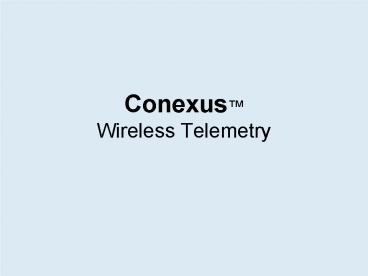Conexus Wireless Telemetry - PowerPoint PPT Presentation
1 / 8
Title:
Conexus Wireless Telemetry
Description:
The FCC established MICS in 1999 to provide an 'ultra-low power, mobile radio ... acceleration of ventricular tachycardia, and surgical complications such ... – PowerPoint PPT presentation
Number of Views:928
Avg rating:3.0/5.0
Title: Conexus Wireless Telemetry
1
Conexus Wireless Telemetry
2
MICS Background
- In the United States, the Federal Communications
Commission (FCC) regulates use of the radio
frequency spectrum, and regulatory rules make a
number of frequency bands potential candidates
for use by medical devices. - However, ONE frequency band is designated
specifically for implanted medical devices the
Medical Implant Communications Service (MICS) - The FCC established MICS in 1999 to provide an
ultra-low power, mobile radio service for
transmitting data in support of diagnostic or
therapeutic functions associated with implanted
medical devices. - The MICS frequency band operates from 402 MHz to
405 MHz. The use of the 402-405 MHz band is
compatible with international frequency
allocations, and these frequencies are conducive
to transmitting radio signals in the human body.
3
Conexus Wireless Telemetry
- Medtronics Conexus Wireless Telemetry operates
on the MICS band - Medtronic strategically chose MICS for optimum
operation in clinics and operating rooms - Conexus Wireless Telemetry employs several
unique mechanisms used to avoid radio
interference, when present including Smart Radio.
4
Smart Radio
- Selects one of 10 channels within the MICS
frequency band to establish a telemetry session
based on the MICS standard Listen Before Talk
(LBT) frequency-access protocol. - Scans all channels in the MICS band for other
users, or noise, prior to establishing a
telemetry session. Conexus Telemetry will open a
session on the least interfered channel. - This protocol allows multiple simultaneous
programming sessions to be collocated without
interference.
5
Conexus Performance Testing
- Conexus has been in development / testing for
nearly 10 years. - Medtronic has initiated variety of testing in
both bench and real world settings. - Users can have confidence in the ability to
conduct all aspects of device interrogation and
programming within labeled range (2-5M)
6
Potential Clinical Applications
- Implant
- Remove programming head from sterile field
- Follow-up
- Perform wandless programming / interrogation
- Potentially eliminate surface electrodes with
Leadless ECG
- Remote Monitoring
- Wirelessly / Automatically transmit device data
to peripheral monitors
7
- Brief Statement Medtronic ICDs and CRT-ICDs
- Indications
- Medtronic Implantable Cardioverter
Defibrillators (ICDs) are indicated for
ventricular antitachycardia pacing and
ventricular defibrillation for automated
treatment of life-threatening ventricular
arrhythmias. - Medtronic Cardiac Resynchronization Therapy
(CRT) ICDs are indicated for ventricular
antitachycardia pacing and ventricular
defibrillation for automated treatment of
life-threatening ventricular arrhythmias and for
the reduction of the symptoms of moderate to
severe heart failure (NYHA Functional Class III
or IV) in those patients who remain symptomatic
despite stable, optimal medical therapy and have
a left ventricular ejection fraction less than or
equal to 35 and a QRS duration of 130 ms. - Contraindications
- Medtronic ICDs and CRT-ICDs are contraindicated
in patients whose ventricular tachyarrhythmias
may have transient or reversible causes, patients
with incessant VT or VF, patients who have a
unipolar pacemaker. Medtronic ICDs are also
contraindicated for patients whose primary
disorder is bradyarrhythmia. - Warnings and Precautions
- Changes in a patients disease and/or
medications may alter the efficacy of the
devices programmed parameters. Patients should
avoid sources of magnetic and electromagnetic
radiation to avoid possible underdetection,
inappropriate sensing and/or therapy delivery,
tissue damage, induction of an arrhythmia, device
electrical reset or device damage. Do not place
transthoracic defibrillation paddles directly
over the device. Additionally, for CRT-ICDs,
certain programming and device operations may not
provide cardiac resynchronization. - Potential Complications
- Potential complications include, but are not
limited to, rejection phenomena, erosion through
the skin, muscle or nerve stimulation,
oversensing, failure to detect and/or terminate
tachyarrhythmia episodes, acceleration of
ventricular tachycardia, and surgical
complications such as hematoma, infection,
inflammation, and thrombosis. - See the device manual for detailed information
regarding the implant procedure, indications,
contraindications, warnings, precautions, and
potential complications/adverse events. For
further information, please call Medtronic at
1-800-328-2518 and/or consult Medtronics website
at www.medtronic.com. - Caution Federal law (USA) restricts these
devices to sale by or on the order of a
physician.
8
- Brief Statement 2090 Programmer
- The Medtronic/Vitatron CareLink programmer
system is comprised of prescription devices
indicated for use in the interrogation and
programming of implantable medical devices.
Prior to use, refer to the Programmer Reference
Guide as well as the appropriate programmer
software and implantable device technical manuals
for more information related to specific
implantable device models. Programming should be
attempted only by appropriately trained personnel
after careful study of the technical manual for
the implantable device and after careful
determination of appropriate parameter values
based on the patient's condition and pacing
system used. The Medtronic/Vitatron CareLink
programmer must be used only for programming
implantable devices manufactured by Medtronic or
Vitatron. - See the device manual for detailed information
regarding the instructions for use, indications,
contraindications, warnings, precautions, and
potential adverse events. For further
information, please call Medtronic at
1-800-328-2518 and/or consult Medtronics website
at www.medtronic.com. - Caution Federal law (USA) restricts this
device to sale by or on the order of a physician.
www.medtronic.com Medtronic USA, Inc. Toll-free
1 (800) 328-2518 (24-hour technical support
for physicians and medical professionals) April
2006































